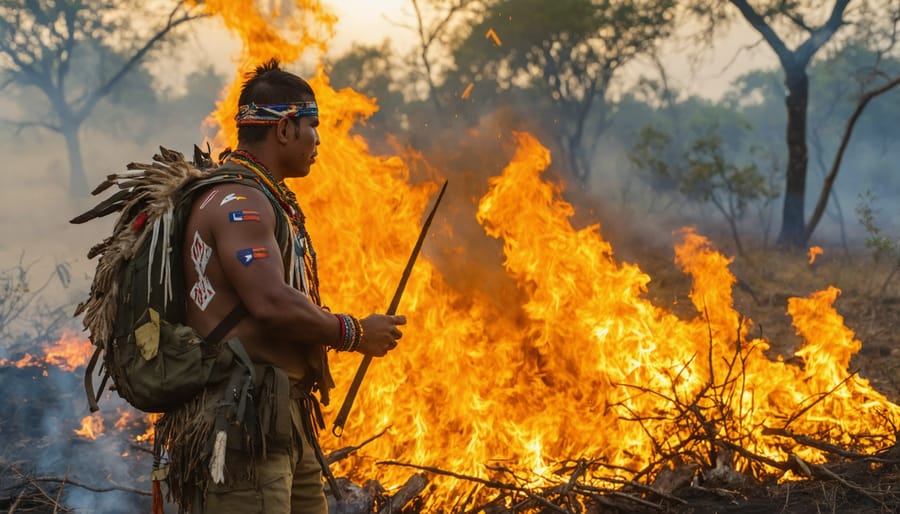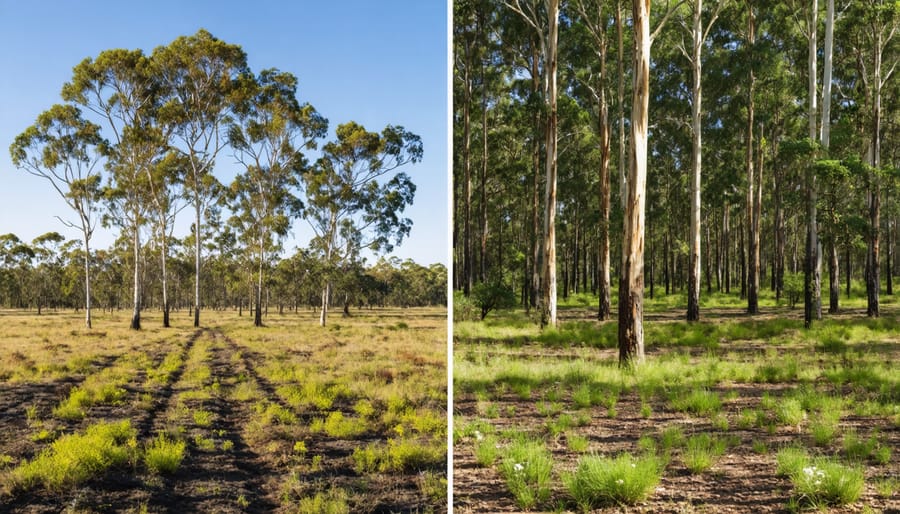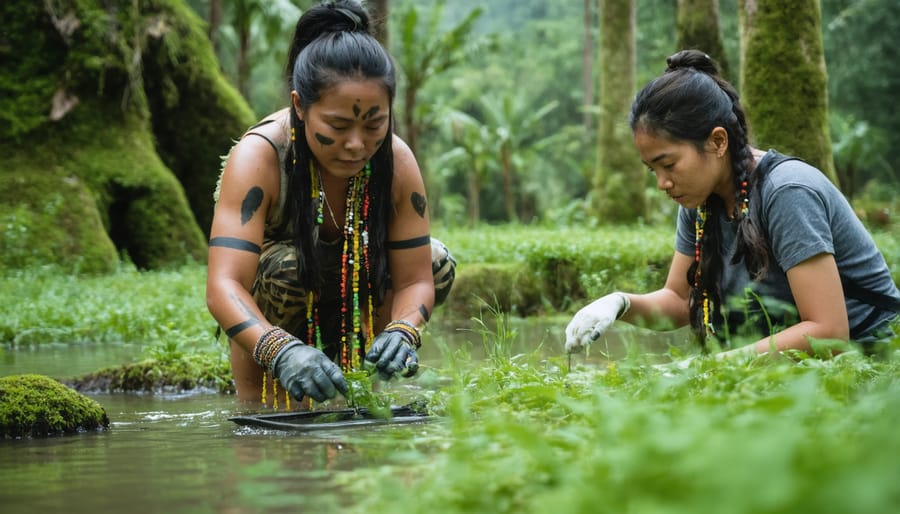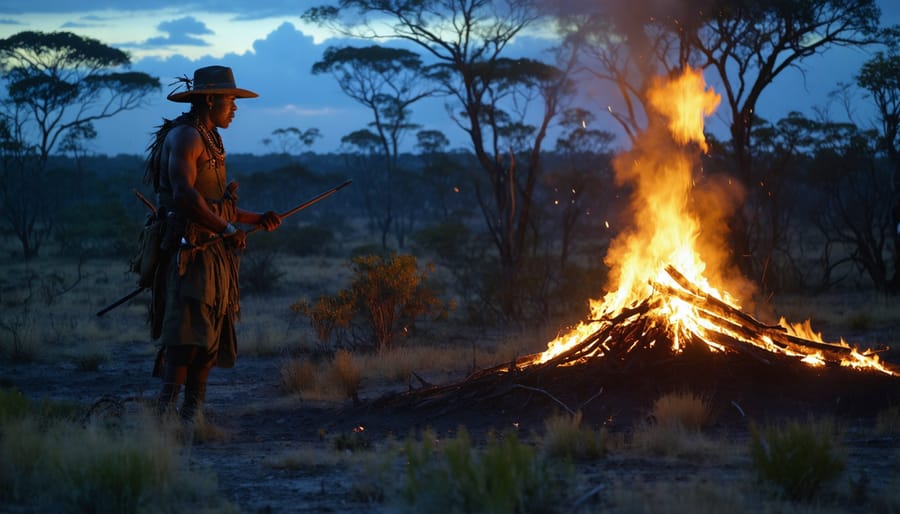For millennia, Indigenous peoples have read the subtle rhythms of the Earth, developing sophisticated systems to manage land, water, and climate. Today, as we grapple with unprecedented environmental challenges, these ancient wisdom systems are proving remarkably relevant to modern climate science.
From the Aboriginal fire management practices of Australia to the traditional agricultural methods of the Amazon’s Indigenous communities, traditional ecological knowledge offers proven solutions for carbon sequestration, biodiversity conservation, and climate resilience. These time-tested approaches have maintained ecological balance for thousands of years, often outperforming contemporary Western methods in both effectiveness and sustainability.
What makes Indigenous knowledge particularly valuable in our fight against climate change is its holistic understanding of ecosystems. While modern science often segments environmental challenges into discrete problems, Indigenous knowledge systems recognize the intricate connections between land, water, wildlife, and human communities. This comprehensive approach provides crucial insights for developing integrated climate solutions that work in harmony with natural systems.
As we seek innovative ways to address the climate crisis, incorporating Indigenous knowledge into mainstream environmental strategies isn’t just respectful – it’s essential for our planetary survival. This ancient wisdom, combined with modern scientific methods, offers our best hope for creating effective, sustainable solutions to global climate challenges.
Traditional Fire Management: Ancient Wisdom Meets Modern Carbon Credits
Cultural Burning Techniques
Cultural burning, practiced by Indigenous Australians for tens of thousands of years, represents a sophisticated approach to land management that’s gaining recognition as a vital tool in climate change mitigation. Unlike conventional hazard reduction burns, traditional fire management involves carefully planned, low-intensity burns conducted at specific times throughout the year.
These burns follow a mosaic pattern, creating patches of differently aged vegetation that support diverse ecosystems. Indigenous fire practitioners read the land’s signals – from flowering patterns to wind directions – to determine the optimal timing and locations for burns. This knowledge, passed down through generations, ensures fires are controlled and beneficial rather than destructive.
The ecological benefits are remarkable. Cultural burns reduce fuel loads gradually, preventing catastrophic bushfires while promoting new growth and maintaining biodiversity. Native grass species often flourish after these controlled burns, and many Australian plants have evolved to depend on this practice for seed germination. The technique also creates natural firebreaks and helps maintain important wildlife corridors.
Modern scientific studies have confirmed what Indigenous communities have long known: these traditional burning practices significantly reduce carbon emissions compared to intense wildfires. The charcoal produced during cultural burns can also sequester carbon in the soil for hundreds of years, contributing to long-term carbon storage while improving soil fertility.

Carbon Abatement Success Stories
Indigenous communities across Australia have demonstrated remarkable success in combining traditional knowledge with modern carbon management practices. The Warddeken Rangers in West Arnhem Land have pioneered one of the most successful carbon farming initiatives, generating over 300,000 tonnes of carbon credits annually through traditional fire management practices.
The Tiwi Islands Carbon Study showcases another inspiring example, where Indigenous rangers have implemented savanna burning projects that not only reduce emissions but also protect biodiversity and create sustainable employment opportunities. Their strategic early-season burning techniques have decreased late-season wildfires by 50% while generating valuable carbon credits.
In the Kimberley region, the Nyikina Mangala people have successfully integrated traditional knowledge into a carbon offset program that combines fire management with native species conservation. This project has created more than 30 full-time jobs for Indigenous rangers while delivering approximately 100,000 carbon credits yearly.
The Olkola Aboriginal Corporation in Cape York has transformed their traditional land management practices into a thriving carbon business. By implementing strategic burning practices learned from their ancestors, they’ve reduced greenhouse gas emissions while maintaining cultural connections to Country. Their success has inspired similar projects across northern Australia, demonstrating how Indigenous ecological knowledge can effectively address climate change while providing economic opportunities for remote communities.
Indigenous Land Management and Carbon Sequestration

Native Vegetation Management
Indigenous Australians have long practiced sophisticated vegetation management techniques that modern science now recognizes as crucial for maintaining biodiversity and enhancing carbon sequestration in soil. Traditional fire management, known as “cultural burning,” involves carefully controlled, low-intensity burns that promote new growth while preventing destructive bushfires and protecting carbon stores in vegetation and soil.
These time-tested practices create a mosaic pattern of different vegetation ages and types, supporting diverse ecosystems that act as natural carbon sinks. Indigenous communities strategically manage understory vegetation, allowing larger trees to thrive and store more carbon while maintaining crucial habitat corridors for native wildlife.
The traditional approach to vegetation management also includes selective harvesting and propagation of native species, which helps maintain the natural balance of plant communities. This knowledge encompasses understanding seasonal changes, plant life cycles, and the intricate relationships between different species within the ecosystem.
Many Indigenous communities continue to practice these methods today, often integrating them with modern conservation techniques. For example, in Northern Australia, Traditional Owners work with scientists to implement traditional burning practices that have been shown to reduce greenhouse gas emissions while promoting biodiversity.
The success of these practices has led to growing recognition of Indigenous ecological knowledge in climate change mitigation strategies. Conservation programs across Australia are increasingly incorporating traditional vegetation management techniques, demonstrating how ancient wisdom can contribute to modern environmental challenges. This integration of traditional and contemporary approaches offers promising solutions for maintaining healthy ecosystems while addressing climate change concerns.
Water Resource Management
Indigenous communities across Australia have long practiced sophisticated water management techniques that not only preserve precious water resources but also contribute significantly to carbon sequestration. These traditional methods, passed down through generations, demonstrate remarkable efficiency in maintaining healthy ecosystems while naturally capturing carbon.
The Aboriginal water management system known as cultural flows ensures that water bodies maintain their natural rhythms, supporting native vegetation that acts as natural carbon sinks. These systems include carefully managed wetlands and billabongs that serve multiple purposes: storing water, providing wildlife habitats, and sequestering carbon in plant matter and soil.
In Northern Australia, Indigenous communities have preserved ancient techniques for managing seasonal floodplains. These practices involve strategic timing of water flows that promote the growth of native vegetation, which in turn captures and stores significant amounts of carbon. The carefully managed flooding and drying cycles create ideal conditions for carbon-rich soil development.
Traditional water harvesting techniques, such as the construction of small weirs and channels, slow water movement across landscapes, reducing erosion while increasing soil moisture. This approach promotes the growth of deep-rooted native plants that are excellent carbon captors. Many communities combine these practices with modern monitoring methods to quantify their carbon sequestration benefits.
These Indigenous water management practices are increasingly being recognized and integrated into contemporary climate change strategies. For example, several Indigenous ranger programs now incorporate traditional water management techniques into their carbon farming projects, demonstrating how ancient knowledge can effectively address modern environmental challenges while creating sustainable economic opportunities for Indigenous communities.
Integrating Indigenous Knowledge into Modern Carbon Markets
Partnership Models
Several successful partnerships between Indigenous communities and carbon market participants demonstrate the powerful potential of combining traditional knowledge with modern carbon capture innovations. The Arnhem Land Fire Abatement (ALFA) project stands as a prime example, where Traditional Owners work alongside carbon market investors to implement traditional fire management practices, resulting in significant carbon emission reductions while creating sustainable income streams for Indigenous communities.
In the Kimberley region, the Warddeken-Conoco Phillips partnership has proven particularly successful, combining Indigenous fire management techniques with modern carbon accounting methods. This collaboration has generated over 150,000 carbon credits annually while protecting culturally significant sites and creating employment opportunities for local Indigenous rangers.
The Indigenous Carbon Industry Network (ICIN) has established a framework for respectful partnerships between Indigenous groups and carbon market participants. Their approach ensures Traditional Owners maintain control over their land while accessing carbon market benefits. The Tiwi Islands Carbon Study represents another successful model, where Indigenous communities partner with researchers to quantify carbon storage in mangrove systems, combining traditional ecological knowledge with scientific methodology.
These partnerships demonstrate how Indigenous communities can maintain cultural practices while participating in the modern carbon economy, creating a win-win situation for both environmental conservation and community development.

Economic Opportunities
Indigenous communities across Australia are discovering valuable economic opportunities through carbon offset projects that combine traditional knowledge with modern carbon markets. The Savanna Burning programs in Northern Australia serve as a prime example, where traditional fire management practices not only reduce greenhouse gas emissions but also generate substantial income through carbon credits.
These initiatives have created meaningful employment for Indigenous rangers and land managers, who earn income while maintaining their connection to country. The Western Arnhem Land Fire Abatement (WALFA) project alone has generated millions of dollars in carbon credits while employing dozens of Indigenous practitioners.
Carbon farming projects on Indigenous lands provide diverse income streams through activities like vegetation management, controlled burning, and forest protection. These projects often attract investment from major corporations seeking to offset their emissions, creating sustainable long-term partnerships that benefit Indigenous communities.
Beyond direct carbon market participation, Indigenous communities are developing eco-tourism ventures that showcase traditional land management practices. These enterprises create additional revenue streams while educating visitors about Indigenous approaches to environmental stewardship.
The economic benefits extend to related industries, including native seed collection, bush food production, and environmental consulting services. Many communities are establishing Indigenous-owned enterprises that combine traditional knowledge with contemporary business practices, creating intergenerational wealth while contributing to climate change mitigation.
Future Pathways: Scaling Indigenous Carbon Solutions
Indigenous carbon management practices have demonstrated remarkable success in reducing emissions while preserving cultural heritage, and the potential for scaling these solutions is immense. As Australia’s energy transformation gains momentum, Indigenous-led carbon initiatives are positioned to play a pivotal role in achieving national emissions reduction targets.
The pathway forward involves expanding successful programs like savanna burning projects across wider regions while maintaining strong Indigenous governance. Key opportunities include developing new methodologies that incorporate traditional knowledge into carbon accounting frameworks and creating partnerships between Indigenous communities and corporate entities seeking high-quality carbon offsets.
Training and capacity building programs are essential to support more Indigenous rangers and carbon project managers. These initiatives not only create meaningful employment but ensure the sustainable transfer of both traditional and contemporary carbon management skills to future generations.
Digital technology is opening new doors for scaling Indigenous carbon solutions. Innovative platforms are being developed to track and verify carbon credits more efficiently, while satellite mapping technology helps Indigenous land managers monitor and assess their projects’ impact over vast territories.
Financial mechanisms are evolving to better support Indigenous carbon projects. Impact investment funds specifically designed for Indigenous environmental enterprises are emerging, providing crucial capital for project expansion. Additionally, carbon credit purchasing agreements are becoming more sophisticated, offering long-term revenue security for Indigenous communities.
The future of Indigenous carbon solutions lies in creating a harmonious blend of traditional knowledge and modern methodologies. By establishing regional carbon management hubs, communities can share resources and expertise while maintaining their unique cultural approaches. This collaborative model has the potential to significantly increase the scale and effectiveness of Indigenous-led carbon initiatives while ensuring benefits flow directly to Traditional Owners.
Success in scaling these solutions requires continued policy support, market recognition of premium Indigenous carbon credits, and strengthened partnerships between Indigenous organizations and the broader carbon market sector.
As Australia faces the growing challenges of climate change, the integration of Indigenous knowledge into our environmental management strategies has emerged as not just an option, but a necessity for our sustainable future. The profound understanding that First Nations peoples have developed over tens of thousands of years offers invaluable insights into managing our landscapes, reducing carbon emissions, and building resilience against climate impacts.
This ancient wisdom, when combined with modern scientific approaches, creates a powerful framework for addressing climate change. The success of Indigenous carbon farming projects, traditional fire management practices, and cultural burning techniques demonstrates how traditional knowledge can deliver practical, measurable benefits while supporting biodiversity and strengthening communities.
Looking ahead, Australia has a unique opportunity to lead the world in incorporating Indigenous ecological knowledge into climate solutions. By embracing this collaborative approach, we can create more effective strategies for carbon reduction, land management, and ecosystem preservation. This partnership between traditional wisdom and contemporary science represents a pathway to not only combat climate change but also to heal Country and create sustainable economic opportunities for Indigenous communities.
The time has come to fully recognise and implement Indigenous knowledge systems in our national climate response. Through respectful partnerships, ongoing dialogue, and genuine commitment to Indigenous leadership, we can build a more resilient and sustainable future for all Australians. This journey of learning from and working alongside First Nations peoples will be essential in securing our environmental legacy for generations to come.

